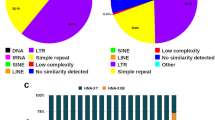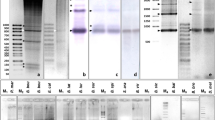Abstract
To document the frequency and distribution of repetitive elements in Peromyscus leucopus, the white-footed mouse, a cosmid genomic library was examined. Two thousand thirteen randomly chosen recombinants, with an average insert size of 35 kb and representing 2.35% of the haploid genome of P. leucopus, were screened with probes representing microsatellites, tandem repeats, and transposable elements. Of the four dinucleotides, (GT)n was present in 87% of the clones, (CT)n was present in 59% of the clones, and (AT)n and (GC)n each was represented in our sample by a single clone (0.05%). (TCC)n was present in 8% of the clones. Of the tandem repeats, the 28S ribosomal probe and the (TTAGGG)n telomere probe were not represented in the library, whereas a heterochromatic fragment was present in 9% of the clones. A transposable element, mys, was estimated to occur in 4700 copies, whereas a long interspersed element (LINE) was estimated to occur in about 41,000 copies per haploid genome. LINE and mys occurred together in the same clones more frequently than expected on the basis of chance. Hybridizing the library to genomic DNA from P. leucopus, Reithrodontomys fulvescens, Mus musculus, and human produced general agreement between phylogenetic relatedness and intensity of hybridization. However, dinucleotide repeats appeared to account for a disproportionately high number of positive clones in the more distantly related taxa.
Similar content being viewed by others
References
Adkins, R.M., McBee, K., Baker, R.J., Porter, C.A. (1991). Chromosomal hybrid zone of Peromyscus leucopus: test of the recombinational breakdown model. J. Mammal. 72, 535–541.
Baker, R.J., Wichman, H.A. (1990). Retrotransposon Mys is concentrated on the sex chromosomes: implications for copy number containment. Evolution 44, 2083–2088.
Baker, R.J., Koop, B.F., Haiduk, M.W. (1983a). Resolving systematic relationships with G-bands: a study of five genera of South American cricetine rodents. Syst. Zool. 29, 239–253.
Baker, R.J., Robbins, L.W., Stangl, F.B., Jr., Birney, E.C. (1983b). Chromosomal evidence for a major subdivision in Peromyscus leucopus. J. Mammal. 64, 356–359.
Baker, R.J., Porter, C.A., Hanks, B.G., Bickham, J.W. (1991). Increased variation in cellular DNA content at a hybrid zone: hybrid breakdown in Peromyscus leucopus. J. Hered. 82, 27–30.
Belmaaza, A., Wallenburg, J.C., Brouillette, S., Gusew, N., Chartrand, P. (1990). Genetic exchange between endogenous and exogenous LINE-1 repetitive elements in mouse cells. Nucleic Acids Res. 18, 6385–6391.
Burton, F.H., Loeb, D.D., Voliva, C.F., Martin, S.L., Edgell, M.H., Hutchison, C.A. III. (1986). Conservation throughout mammalia and extensive protein encoding capacity of the highly repeated DNA L1. J. Mol. Biol. 187, 291–304.
Carleton, M.D. (1980). Phylogenetic relationships in neotomineperomyscine rodents (Muroidea) and a reappraisal of the dichotomy within New World Cricetinae. Misc. Publ. Mus. Zool. Univ. Michigan 157, 1–146.
Carleton, M.D. (1989). Systematics and evolution. In Advances in the Study of Peromyscus (Rodentia), G.C. Kirkland, Jr., J.N. Layne, eds. (Lubbock, Texas: Texas Tech University Press), pp. 7–141.
Crampton, J.M., Davies, K.E., Knapp, T.P. (1981). The occurrence of families of repetitive sequences in a library of cloned cDNA from human lymphocytes. Nucleic Acids Res. 9, 3821–3834.
Crew, M.D., Smith, G.S., Zeller, E.C., Walford, R.L. (1989). Polymorphism in the major histocompatibility complex class II genes of Peromyscus leucopus. Immunogenetics 30, 214–217.
Crew, M.D., Filipowsky, M.E., Zeller, E.C., Smith, G.S., Walford, R.L. (1990). Major histocompatibility complex class I genes of Peromyscus leucopus. Immunogenetics 32, 371–379.
Epplen, J.T., Ammer, H., Epplen, C., Kammerbauer, C., Mitreiter, R., Roewer, L., Schwaiger, W., Steimle, V., Zischler, H., Albert, E., Andreas, A., Beyermann, B., Meyer, W., Buitkamp, J., Nanda, I., Schmid, M., Nürnberg, P., Pena, S.D.J., Pöche, H., Sprecher, W., Schartl, M., Weising, K., Yassouridis, A. (1991). Oligonucleotide fingerprinting using simple repeat motifs: a convenient, ubiquitously applicable method to detect hypervariability for multiple purposes. In DNA Fingerprinting: Approaches and Applications, T. Burke, G. Dolf, A.J. Jeffries, and R. Wolff, eds. (Basel, Switzerland: Birkhäuser Verlag), pp. 50–69.
Evans, G.A., Lewis, K., Rothenberg, B.E. (1989). High efficiency vectors for cosmid microcloning and genomic analysis. Gene 79, 9–20.
Feinberg, A.P., Vogelstein, B. (1983). A technique for radiolabeling DNA restriction endonuclease fragments to high specific activity. Anal. Biochem. 132, 6–13.
Gerbi, S.A. (1985). Evolution of ribosomal DNA. In Molecular Evolutionary Genetics, R.J. MacIntyre, ed. (Plenum Publishing Corp.), pp. 419–517.
Hamada, H., Petrino, M.G., Kakunaga, T. (1982). A novel repeated element with Z-DNA-forming potential is widely found in evolutionarily diverse eukaryotic genomes. Proc. Natl. Acad. Sci. USA 79, 6465–6469.
Hamilton, M.J., Hong, G., Wichman, H.A. (1992). Intragenomic movement and concerted evolution of satellite DNA in Peromyscus: evidence from in situ hybridization. Cytogenet. Cell Genet. 60, 40–44.
Kass, D.H., Berger, F.G., Dawson, W.D. (1992). The evolution of coexisting highly divergent Line-1 subfamilies within the rodent genus Peromyscus. J. Mol. Evol. 35, 472–485.
Kirkland, G.L., Jr., Layne, J.N. (eds.) (1989). Advances in the Study of Peromyscus (Rodentia). (Lubbock, Texas: Texas Tech University Press).
Korenberg, J.R., Rykowski, M.C. (1988). Human genome organization: Alu, Lines, and the molecular structure of metaphase chromosome bands. Cell 53, 391–400.
Longmire, J.L., Lewis, A.K., Brown, N.C., Buckingham, J.M., Clark, L.M., Jones, M.D., Meincke, L.J., Meyne, J., Ratliff, R.L., Ray, F.A., Wagner, R.P., Moyzis, R.K. (1988). Isolation and molecular characterization of a highly polymorphic centromeric tandem repeat in the family Falconidae. Genomics 2, 14–24.
Marks, J., Schmid, C.W., Sarich, V.M. (1989). DNA hybridization as a guide to phylogeny: relations of the Hominoidea. J. Hum. Evol. 17, 769–786.
McBee, K. (1991). Chromosomal aberrations in native small mammals (Peromyscus leucopus) at a petrochemical waste disposal site. II. Inherited aberrations and fragile sites indicated by G-band analysis. Environ. Toxicol. Chem. 10, 1321–1329.
McBee, K., Bickham, J.W., Brown, K.W., Donnelly, K.C. (1987). Chromosomal aberrations in native small mammals (Peromyscus leucopus and Sigmodon hispidus) at a petrochemical waste disposal site. I. Standard karyology. Arch. Environ. Contam. Toxicol. 16, 681–688.
Meyne, J., Baker, R.J., Hobart, H.H., Hsu, T.C., Ryder, O.A., Ward, O.G., Wiley, J.E., Wurster-Hill, D.H., Yates, T.L., Moyzis, R.K. (1990). Distribution of nontelomeric sites of the (TTAGGG)n telomeric sequence in vertebrate chromosomes. Chromosome 99, 3–10.
Moyzis, R.K., Buckingham, J.M., Cram, L.S., Dani, M., Deaven, L.L., Jones, M.D., Meyne, J., Ratliff, R.L., Wu, J.R. (1988). A highly conserved repetitive DNA sequence, (TTAGGG)n present at the telomeres of human chromosomes. Proc. Natl. Acad. Sci. USA 85, 6622–6626.
Moyzis, R.K., Torney, D.C., Meyne, J., Buckingham, J.M., Wu, J.-R., Burks, C., Sirotkin, K.M., Goad, W.B. (1989). The distribution of interspersed repetitive DNA sequences in the human genome. Genomics 4, 273–289.
Nelson, K., Baker, R.J., Honeycutt, R.L. (1985). Mitochondrial DNA and protein differentiation between hybridizing cytotypes of the white-footed mouse, Peromyscus leucopus. Evolution 41, 864–872.
Pardue, M.L., Lowenhaupt, K., Rich, A., Nordheim, A. (1987). (dC-dA)n · (dG-dT)n sequences have evolutionarily conserved chromosomal locations in Drosophila with implications for roles in chromosome structure and function. EMBO J. 6, 1781–1789.
Pine, D.S., Bourekas, E.C., Potter, S.S. (1988). Mys retrotransposons in Peromyscus leucopus and transgenic Mus musculus. Nucleic Acids Res. 16, 3359–3373.
Sambrook, J., Fritsch, E.F., Maniatis, T. (1989). Molecular Cloning: A Laboratory Manual. 2nd ed. (Plainview, NY: Cold Spring Harbor Laboratory Press).
Sarich, V.M., Schmid, C.W., Marks, J. (1989). DNA hybridization as a guide to phylogeny: a critical analysis. Cladistics 5, 3–32.
Sibley, C.G., Ahlquist, J.E. (1990). Phylogeny and Classification of Birds. A Study in Molecular Evolution. (New Haven, Conn.: Yale Univ. Press).
Singer, M.F. (1982). Highly repeated sequences in mammalian genomes. Int. Rev. Cytol. 76, 67–112.
Smith, G.S., Crew, M.D., Walford, R.L. (1989). Peromyscus as a gerontologic animal: aging and the MHC. In Genetic Effects on Aging II, (D.E. Harrison, ed.). (Caldwell, N.J.: Telford Press), pp. 457–472.
Stallings, R.L. (1992). CpG suppression in vertebrate genomes does not account for the rarity of (CpG) n microsatellite repeats. Genomics 17, 890–891.
Stallings, R.L., Torney, D.C., Hildebrand, C.E., Longmire, J.L., Deavin, L.L., Jett, J.H., Doggett, N.A., Moyzis, R.K. (1990). Physical mapping of human chromosomes by repetitive sequence fingerprinting. Proc. Natl. Acad. Sci. USA 87, 6218–6222.
Stallings, R.L., Ford, A.F., Nelson, D., Torney, D.C., Hildebrand, C.E., Moyzis, R. (1991). Evolution and distribution of (GT) n repetitive sequences in mammalian genomes. Genomics 10, 807–815.
Stangl, F.B., Jr. (1986). Aspects of a contact zone between two chromosomal races of Peromyscus leucopus (Rodentia: Cricetidae). J. Mammal. 67, 465–473.
Wellauer, P.K., Dawid, I.B. (1979). Isolation and sequence organization of human ribosomal DNA. J. Mol. Biol. 128, 280–303.
Wichman, H.A., Potter, S.S., Pine, D.S. (1985). Mys, a family of mammalian transposable elements isolated by phylogenetic screening. Nature 317, 77–81.
Wichman, H.A., Payne, C.T., Reeder, T.W. (1990). Intragenomic variation in repetitive sequences isolated by phylogenetic screening of mammalian genomes. In Molecular Evolution, M.T. Clegg and S.J. O'Brien, eds., (New York: Alan R. Liss), pp. 153–160.
Wichman, H.A., Van Den Bussche, R.A., Hamilton, M.J., Baker, R.J. (1992). Transposable elements and the evolution of genome organization in mammals. Genetica 86, 287–293.
Author information
Authors and Affiliations
Rights and permissions
About this article
Cite this article
Janecek, L.L., Longmire, J.L., Wichman, H.A. et al. Genome organization of repetitive elements in the rodent, Peromyscus leucopus . Mammalian Genome 4, 374–381 (1993). https://doi.org/10.1007/BF00360588
Received:
Accepted:
Issue Date:
DOI: https://doi.org/10.1007/BF00360588




